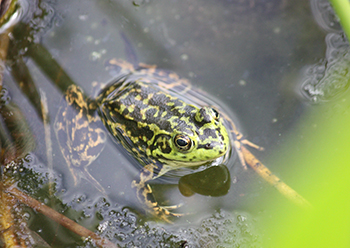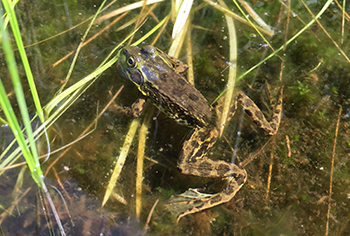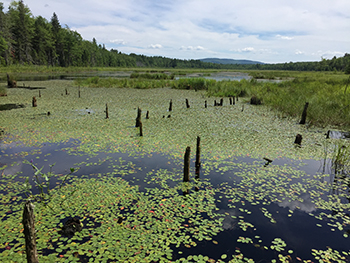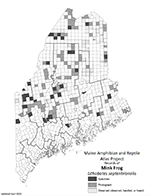Home → Fish & Wildlife → Wildlife → Species Information → Reptiles & Amphibians → Mink Frog
Mink Frog
Lithobates septentrionalis
On this page:

Photo: Trevor Persons
Distinguishing Characteristics

Photo: Trevor Persons
- Medium-sized, approximately 1.5 to 3 inches in length
- Greenish with dark spots or reticulations on back, underside grayish white, chin may be pale yellowish
- Irregular rectangular dark blotches on hind limbs oriented along long axis of legs
- Dorsolateral folds along sides of back may be present or absent
- Distinct “musky” or “rotten onion” smell gives this frog its name
- Commonly confused with green frog
- Breeding call sounds like two pieces of wood being tapped together
Status and Distribution in Maine
- Species of Greatest Conservation Need
- Common
- Western, central, eastern, and northern regions
Habitat

Photo: Trevor Persons
- Ponds, lakes, bogs, and streams with shallow areas of dense emergent vegetation
Diet
- Tadpoles eat algae, and adults eat aquatic invertebrates and sometimes small minnows
Seasonal Changes
- Hibernate in mud at bottom of ponds or streams
Natural History Notes
- Highest-latitude southern range edge of any frog; scientific name roughly translates as "frog of the north"
- Reduced oxygen content of warmer water may be factor limiting southern extent of range, as high water-oxygen levels are needed to penetrate egg masses
- Breeds later than most frogs, from late June through early August
- Most calling activity takes place after midnight
- Highly aquatic, rarely found on land
Share Your Sighting
There is much still to learn about the distribution and ecology of Maine’s herpetofauna, and we encourage members of the public to share their photo-documented observations as part of the Maine Amphibian & Reptile Atlas Project (MARAP).
To see if a township still needs documentation of a species, consult this distribution map (PDF). If a township lacks a photo or specimen record, we want your observation!
There are two ways to share your observations:
Submit your reptile or amphibian observation online
No service? No problem. Click here to download the survey to your device while connected, then take offline to collect observations from anywhere. Tip: The survey works best on Google Chrome and Safari.
Or upload sightings to the iNaturalist citizen science project through their website at iNaturalist.org or mobile app.
- When submitting an observation through iNaturalist add a description of the location (and other noteworthy information) to the “notes” field. This serves as a check on the locations automatically generated by smartphone cameras, which may be imprecise if cell service or GPS coverage is weak.
Thank you for doing your part to help conserve Maine’s reptiles and amphibians.
